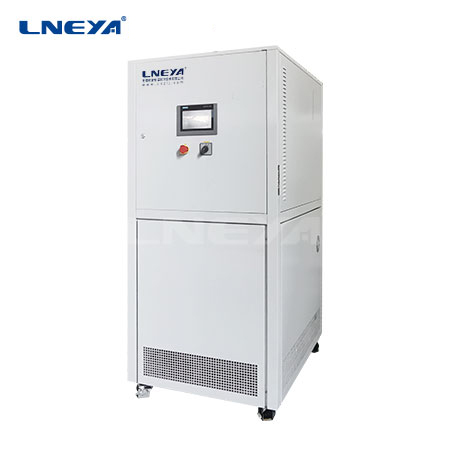Closed Recirculating Cooling Water System
Kontaktieren Sie uns noch heute für die perfekte Lösung zur Temperaturkontrolle
A closed recirculating cooling water system uses cooling water to pass through a heat exchanger to cool process media or materials. Through heat exchange, the temperature of the cooling water rises and becomes hot water, and then other cooling media (such as air) are used to cool the hot water. The cooled water is recycled due to the temperature drop.
The secondary cooler uses other cooling media (such as air) to cool the hot water after the temperature has been raised. The secondary cooler is also a heat exchanger. Its outside is often equipped with wing-shaped fins or other shaped heat sinks made of materials with high thermal conductivity (such as aluminum, copper) to increase the heat dissipation area and improve cooling efficiency. . Some designs place the secondary cooler equipped with wing-shaped fins in a mechanical ventilation cooling tower, which can greatly improve the cooling efficiency.
Because the cooling water of the closed recirculating cooling water system is closed and generally has no material exchange with the outside world, the concentration of various minerals and ions in the closed recirculating cooling water system hardly changes.

The characteristic of the closed recirculating cooling water system is that it does not come into contact with the air, but dissolved oxygen still exists in the actual system. This is due to leaks in valves, pipe interfaces, water pump packing, etc., which bring in a small amount of oxygen. In addition, small amounts of supplemental water are also a source of dissolved oxygen. Therefore, there is chemical corrosion of oxygen in the closed recirculating cooling water system. Since the system is usually composed of different metal materials, which may be copper or copper-nickel alloy heat exchange tubes, stainless steel, galvanized steel pipes or mild steel pipes, the closed recirculating cooling water system also has problems caused by different metal materials. electrochemical corrosion. The closed recirculating cooling water system commonly uses softened water as supplementary water, or natural water treated with simple methods as supplementary water.
Closed recirculating cooling water systems are generally only used in industrial production systems with small heat transfer or special requirements, such as air conditioners, generators, internal combustion engines, transformer oil coolers, auxiliary coolers of nuclear reactors, etc. Closed recirculating cooling water systems are generally used for single heat exchange equipment.
E-Mail: info@lneya.com WeChat ID: +8615251628237 WhatsApp: +86 17851209193
 Präzisionskältemaschinen / Kleinkältemaschinen
Präzisionskältemaschinen / Kleinkältemaschinen
Die Kältemaschine kann in verschiedenen Industrien und Labors eingesetzt werden und unterstützt kundenspezifische Designs.
| Temperaturbereich | -18°C ~ +30°C | +5°C ~ +35°C Reihe |
| Kühlleistung | 0,35 ~ 0,9kW | 1,8 ~ 50kW |

Rückkühler
Unser Rückkühler arbeitet mit Niedertemperatur-Kältetechnik, die Temperatur beträgt bis zu -120℃, und verschiedene Zubehörteile sind anpassbar.
| Temperaturbereich | Serie -25°C ~ +30°C | -45°C ~ +30°C Reihe | Serie -60°C ~ -20°C | Serie -80°C ~ -20°C | Serie -120°C ~ -70°C |
| Kühlleistung | 0,8 ~ 30kW | 0,75 ~ 12kW | 0,4 ~ 6kW | 0,2 ~ 6kW | 0,3 ~ 5kW |

Niedertemperatur-Kühlgeräte
Wir haben uns auf die Herstellung von Niedertemperaturkältemaschinen mit einem Temperaturregelbereich von bis zu -150°C spezialisiert, die den Kühlbedarf verschiedener Branchen decken.
| Temperaturbereich | Serie -25°C ~ -5°C | Serie -45°C ~ -10°C | Serie -60°C ~ -10°C | Serie -80°C ~ -30°C | Serie -110°C ~ -50°C | Serie -150°C ~ -110°C |
| Kühlleistung | 12 ~ 360kW | 6 ~ 180kW | 6 ~ 180kW | 4 ~ 180kW | 2 ~ 120kW | 2,5 ~ 11kW |
Temperatursimulation für die Qualitätsprüfung von Fahrzeugen: Prüfung der Batterielebensdauer, Prüfstand für Einspritzdüsen/Motoren, Airbag-Prüfung, Komponentenprüfstand, usw.

Geeignet für die präzise Temperaturkontrolle von elektronischen Bauteilen. Bei der Herstellung von elektronischen Halbleiterkomponenten für raue Umgebungen umfassen die Phasen der IC-Gehäusemontage sowie der Entwicklungs- und Produktionstests auch elektronische Wärmetests und andere Simulationen von Umwelttests.

Flüssigkeitskühlung für Batterie-Energiespeichersysteme
| Typen | Für Converting Station | Für Energiespeicherbatterie | Für die Ladestation |
| Kühlleistung | 45kW | 5 ~ 8,5kW | 4kW |

Baureihe ZLFQ
Kühlmittelverteilereinheit
Flüssigkeitskühlgeräte eignen sich für die Prüfung von Halbleitern, die Prüfung elektronischer Geräte bei konstanter Temperatur, die Kühlung der Serverinfrastruktur und andere Orte, an denen die Temperatur von Flüssigkeiten kontrolliert wird.
| Temperaturbereich | +5°C ~ +35°C | +5°C ~ +35°C |
| Kühlleistung | 15 ~ 150kW | 200 ~ 500kW |

MD-Thermofutter-Serie
Es wird für die Prüfung von HF-Bauteilen und Leistungsbauteilen mit hoher Dichte (IGBTs und MOSFETs) verwendet und kann auch für die schnelle Kühlung von flachen Laborplatten (Plasma, biologische Produkte, Batterien) usw. eingesetzt werden.
| Temperaturbereich | -75°C ~ +225°C |
| Temperaturgenauigkeit | ±0.1℃ |

Schraubenkühler (Benutzerdefinierte Designs)
Niedertemperatur-Schraubenkühlmaschinen und Raumtemperatur-Schraubenkühlmaschinen
| Temperaturbereich | +5°C ~ +30°C | +5°C ~ +30°C | +5°C ~ +30°C | +5°C ~ +30°C | -25°C ~ +5°C | -25°C ~ +5°C |
| Kühlleistung | 107 ~ 1027kW (Einzelverdichter) | 299 ~ 2134kW (Doppelkompressor) | 98 ~ 934kW (Einzelverdichter) | 272 ~ 1940kW (Doppelkompressor) | 48 ~ 467kW (Einzelverdichter) | 51 ~ 497kW (Einzelverdichter) |
 LNEYA
LNEYA
 简体中文
简体中文



















































































